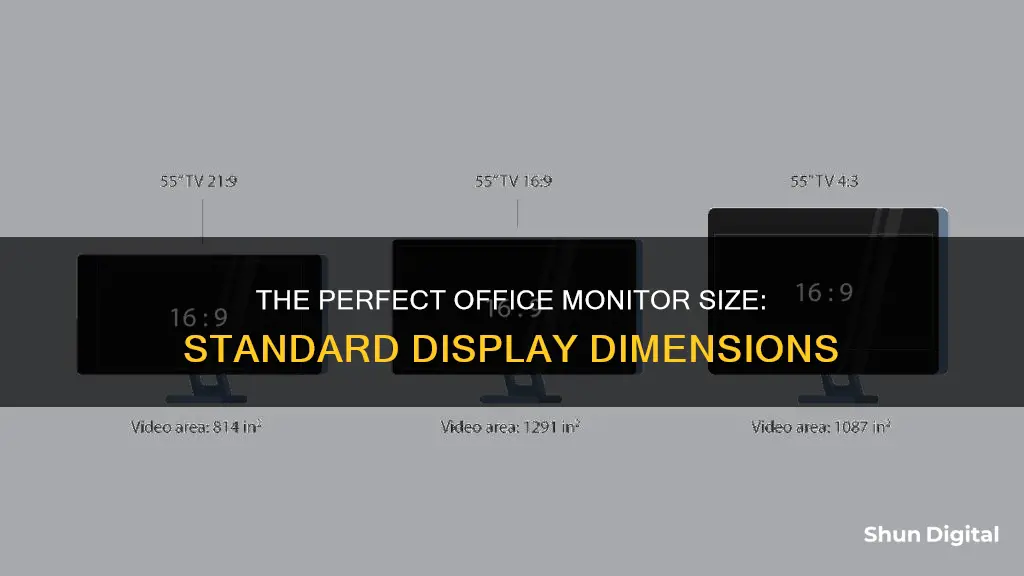
When it comes to choosing a monitor for your home office, there are several factors to consider, including size, resolution, and ergonomics. While the best monitor size will ultimately depend on individual preferences and needs, a few guidelines can help you make an informed decision.
For standard office work, a well-balanced monitor size is essential. The monitor should be large enough to display content clearly but not so large that it becomes cumbersome or tiring for your eyes to move back and forth. For most people, a 24-inch monitor is a good starting point and often considered the baseline. However, with the increasing popularity of ultrawide and curved monitors, many now consider 24 inches a bit on the small side. Monitors with a screen size of 27 inches are quite popular, and options are available that stretch beyond 30 inches.
If you're primarily using your monitor for tasks like word processing, email, and web browsing, a 27-inch or smaller monitor will likely be sufficient. On the other hand, if you work in video editing or other creative fields, a larger screen size, such as 32 inches or more, can be advantageous, allowing you to edit with greater detail and have multiple windows open simultaneously.
In addition to size, resolution is another critical factor. A higher resolution provides more detail and clarity, which is particularly useful for reading small text or working with images. A resolution of 1920 x 1080 (Full HD) or higher is generally recommended.
Lastly, ergonomics play a vital role in choosing a monitor for extended periods of office work. Look for a monitor with adjustable height, tilt, and swivel functions to reduce eye and neck strain.
Characteristics of a Standard Office Monitor
| Characteristics | Values |
|---|---|
| Size | 24-27 inches |
| Resolution | 1920 x 1080 or higher |
| Aspect Ratio | 16:9 or 16:10 |
| Brightness Level | 250-350 cd/m2 |
| Contrast Ratio | 1000:1 |
| Refresh Rate | 60 Hz |
| Viewing Angle | 170 degrees |
What You'll Learn

A 24-inch monitor is the baseline for most users
A 24-inch monitor is also a good choice if you want to view multipage documents or watch streaming video but have limited desk space and a tight budget. While a 27-inch or 32-inch display will give you a superior viewing experience, a 24-inch monitor is a good balance between size and cost.
If you're looking for a monitor for gaming, a 24-inch screen is a good option as it falls within the range of 24 to 32 inches that PC gamers tend to gravitate towards. These sizes let you make the most of modern resolutions and colour clarity, and they also fit a couple of open web pages at the same time without needing to use two monitors, which is handy for many professionals.
For those who want a higher resolution than 1080p, a 24-inch monitor may not be ideal. While you can get a 24-inch monitor with a resolution of 2560 x 1440, this may result in text and images appearing pixelated. For a higher resolution, it's better to opt for a larger screen size, such as a 27-inch or 32-inch monitor.
Understanding Monitor Sizes: A Guide to Choosing the Right Display
You may want to see also

27-inch monitors are popular, but may be too big for 1920 x 1080 resolution
27-inch monitors are popular, but some people find that a resolution of 1920 x 1080 is too low for this size. This is because a higher resolution means a higher detail sharpness, and a monitor with a higher resolution will be able to display finer details with a sharper image.
The detail resolution of a screen is measured in pixels per inch (ppi). A higher pixel density means that more detail can be displayed on the monitor. For example, a 27-inch monitor with a resolution of 2560 x 1440 (WQHD) will offer much more workspace than Full HD (1920 x 1080), especially if multiple windows are used simultaneously.
A 27-inch monitor with a resolution of 1920 x 1080 will have a pixel density of around 81 to 82 ppi. This can result in text appearing noticeably smudgy and details looking blurry. While this can be mitigated by sitting further away from the monitor, this may not be ideal, especially when working on tasks that require closer inspection, such as editing text or photos.
For this reason, a resolution of 1920 x 1080 is generally considered more suitable for monitors up to 25 inches in size. For a 27-inch monitor, a resolution of 2560 x 1440 or higher is often preferred. This will provide a better balance between picture clarity, detail, and screen size.
Monitoring Employee Internet Usage: Company Strategies and Tactics
You may want to see also

21-inch to 25-inch monitors are ideal for 1080p
A 21-inch monitor will give you a "golden ratio" of 100-120 pixels per inch, where most people don't notice pixels, blurriness, or overly sharp edges. However, for gamers, 21 inches is considered too small. A 25-inch monitor is the smallest size that is suitable for gaming.
A 25-inch monitor is ideal if you don't have a lot of desk space. The smaller screen also helps if you want to see everything within your field of vision without moving your eyes too much. Gaming monitors of this size tend to have high refresh rates and a 1080p resolution, making them ideal for competitive gaming. They also don't put too much pressure on your graphics card.
While 1080p was once the gold standard for resolution, today it is considered the baseline. If you want to go for a larger monitor, you should consider a higher resolution as well. For a 27-inch monitor, a resolution of 1440p is ideal, while for a 32-inch monitor, you should opt for 4K.
Monitoring Broadband Usage: BT's Easy Guide to Tracking
You may want to see also

27-inch monitors are ideal for 1440p or 4K
A 27-inch monitor with a 1440p resolution (also known as WQHD or 2K) provides a great balance of detail, usable desktop space, and price. It offers nearly twice the number of pixels as a 1080p monitor, resulting in sharper text and images. This resolution is also better suited for gaming, as even the fastest, most expensive graphics cards struggle to play modern titles at 4K resolutions. With a 27-inch 1440p monitor, you can sit close to the screen and relish the details without experiencing eye strain. Additionally, this size and resolution combination allows for a higher refresh rate, which is beneficial for gaming and provides a smoother on-screen experience.
While a 27-inch monitor can accommodate a 4K resolution, there are some considerations to keep in mind. 4K provides a significant boost in sharpness and detail, with 2.25 times the number of pixels compared to a 1440p monitor. However, it also comes at a higher cost, and you may need to scale up text and images to maintain readability, especially if you have poor eyesight. Additionally, a powerful graphics card is required to run games at 4K resolution, and finding affordable monitors with high refresh rates and a high-quality panel can be challenging.
For most users, a 27-inch 1440p monitor strikes the perfect balance. It offers a high level of detail and clarity while being more affordable and easier to power than a 4K monitor. It provides ample screen real estate for multitasking and is versatile enough for both productivity and gaming.
When choosing a 27-inch monitor, consider your specific needs and budget. If you require a monitor primarily for productivity, look for features like ergonomic stands, USB hubs, and a high contrast ratio for improved image quality. For gaming, focus on features like high refresh rates, low response times, and AMD FreeSync technology to eliminate screen tearing.
In summary, 27-inch monitors are well-suited for 1440p or 4K resolutions, offering a versatile option that delivers a balance of size, resolution, and cost. Whether you're a gamer, a creative professional, or a multitasker, a 27-inch monitor in either of these resolutions can provide an immersive and enjoyable experience.
Monitoring Reserved Instance Usage: Strategies for Cloud Cost Optimization
You may want to see also

28-inch to 32-inch and over monitors are ideal for 4K
When it comes to choosing a monitor, the question of which is the best size is rather subjective. The best monitor size will be the one that fits your needs.
If you're looking for a monitor that is ideal for 4K, then 28-inch to 32-inch and over monitors are a great option. Here's why:
28-inch to 32-inch monitors offer a large screen size that can easily accommodate several application windows open side by side. This makes them ideal for multitasking and improves workflow efficiency. The larger screen size also means that texts and graphics are displayed in a larger, clearer size, reducing eye strain.
In terms of resolution, 4K (3840 x 2160 pixels) delivers sharp text and detailed images. It provides a high pixel density, resulting in crisp visuals and an improved viewing experience. 4K is also ideal for professional video or photo editing, as it allows you to view content in its native resolution.
When it comes to connectivity, 28-inch to 32-inch monitors typically offer a variety of ports, including HDMI, DisplayPort, and USB-C. This makes them versatile and compatible with multiple devices. Some even include a USB hub, allowing you to connect peripherals directly to the monitor.
Additionally, monitors in this size range often come with adjustable stands, allowing you to tilt, swivel, and adjust the height to find the most comfortable viewing position. This is important for maintaining good posture and reducing neck and back strain.
It's worth noting that while larger monitors offer many benefits, they also require more desk space and need to be positioned at an appropriate distance to avoid eye strain.
Overall, if you're looking for a monitor that provides a high-quality viewing experience, ample screen real estate, and versatility for different tasks, a 28-inch to 32-inch or larger monitor is a great choice, especially if you plan to work with 4K content.
Monitoring JVM Memory Usage in WebLogic: A Comprehensive Guide
You may want to see also
Frequently asked questions
The standard size for an office monitor is typically between 24 and 27 inches. However, the size you choose depends on your specific needs and the space you have available.
When selecting an office monitor, it is essential to consider factors such as size, resolution, and ergonomics. A larger monitor can improve productivity by providing more screen space, but it also takes up more desk space. A resolution of 1920x1080 or higher is recommended for clear text and image display. Additionally, look for a monitor with adjustable height, tilt, and swivel to reduce eye and neck strain during long work hours.
Here are some recommended office monitors based on size and features:
- Dell UltraSharp U2715H 27-Inch LED Monitor: This monitor offers a large 27-inch display with a resolution of 2560x1440. It also has good ergonomics, including a height-adjustable stand and a tilt/swivel base.
- BenQ PD2700Q 27-inch QHD 1440p IPS Monitor: This monitor has a 27-inch display, a resolution of 2560x1440, and good ergonomics with a height-adjustable stand and tilt/swivel base.
- LG 34WL500-B 34" 21:9 UltraWide Full HD HDR10 IPS LED Monitor: If you're looking for an ultrawide option, this monitor provides a 34-inch display with a resolution of 3440x1440. It also offers good ergonomics, including a height-adjustable stand and tilt/swivel functionality.







